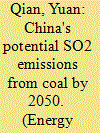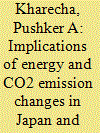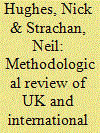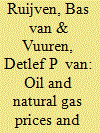|
|
|
Sort Order |
|
|
|
Items / Page
|
|
|
|
|
|
|
| Srl | Item |
| 1 |
ID:
126561


|
|
|
|
|
| Publication |
2013.
|
| Summary/Abstract |
This paper presents an analysis of public preferences for a low carbon future UK and compares them with three future scenarios proposed by the UK government based on data from 10,983 self-selected participants who engaged in the UK Department of Energy and Climate Change 'My2050' online simulation. Participants expressed a stronger preference for demand-side options than for supply-side ones. They also chose fuel switching (to electricity) and technical energy efficiency measures above more behaviour focused options. Renewable energy options (wind, solar, marine and hydro) were preferred to other low carbon supply options (nuclear power, carbon capture and storage), with offshore wind power more popular than onshore. Nuclear power was the least popular generation option. Acceptability of the government's three proposed scenarios was tested by comparing these scenarios with the research findings. Greatest support was suggested for the two scenarios emphasising business greenness, home energy efficiency, electrification of home heating and travel behaviour. The lowest level of support was demonstrated for the scenario based on significant growth in nuclear power with minimal increases in energy efficiency. Despite issues regarding the representivity of the sampled respondents, the work demonstrates the possibility of using outputs from the tool to assess publically preferred pathways.
|
|
|
|
|
|
|
|
|
|
|
|
|
|
|
|
| 2 |
ID:
177165


|
|
|
|
|
| Summary/Abstract |
Coal is the dominant emitter of Sulfur Dioxide (SO2) in some countries, comprising ~92% of total emissions in China. Mitigation of these emissions can be driven by a number of factors, such as energy-efficiency improvements, installation of scrubbers, and use of renewable energy. This study evaluates the historical reduction of overall SO2 emission intensity from coal consumption for 30 Chinese provinces between 2000 and 2016. These trends are further combined with expected coal use from 2020 to 2050 along with scenarios of future power generation to explore China's future SO2 emissions. The results show that provinces starting with a high emission intensity in general have higher reduction rates. By 2050, China's potential SO2 emissions are between 3.9 Mt and 4.1 Mt, and industry mitigation efforts, such as the installation of scrubbers, appear to contribute most to abatement. Additionally, this study estimates the impact on global average temperatures from SO2 mitigation due to the adoption of renewables in the electric sector using the MAGICC model and find an increase of ~0.01 °C by 2050. Considering the reduced abatement opportunities of desulfurization technologies and climate change effects of coal combustion, renewable energy provides the most promising option for SO2 mitigation.
|
|
|
|
|
|
|
|
|
|
|
|
|
|
|
|
| 3 |
ID:
110576


|
|
|
|
|
| Publication |
2011.
|
| Summary/Abstract |
Many scenarios have been generated in the last years analysing the international energy market. The variety of these scenarios is manifold, as they are generated by different institutions using different methodological approaches and different framework assumptions. However, these scenarios can roughly be classified into three main groups: "moderate", "climate protection" and "resource scarcity and high fossil fuel prices". Analysing the German energy market makes a fourth scenario group necessary, which considers the possible revision of the decided nuclear energy phase out. Most of the existing scenarios developed by different institutions can be allocated into one of these groups. A representative scenario for each group has been selected to illustrate the development of the energy sector until 2030. Contrary to the worldwide primary energy demand (PED), the German PED decreases in each scenario, even though the drop differs strongly throughout the scenarios. On the other hand the structure of the PED in 2030 varies strongly for each scenario, especially regarding the share of fossil energy sources. However, a common robust result can be observed throughout all scenarios, namely the high increase in the share of the renewable energy resources, although the scenario generation processes are not always robust.
|
|
|
|
|
|
|
|
|
|
|
|
|
|
|
|
| 4 |
ID:
110352


|
|
|
|
|
| Publication |
2011.
|
| Summary/Abstract |
This article describes the Russian Far East's energy sector, stressing its limited energy exports, and use of separate electricity and heating grids to geographically dispersed population centers with various supply patterns distributed across a vast territory. One key strategic trend has been to strengthen the potential of the region as an energy supplier for the countries of Northeast Asia. This underlies the framework used to develop three energy scenarios of the Russian Far East's energy future through 2030: Reference, National Alternative and Regional Alternative. While the Regional Alternative case has much greater total costs for implementation, yields almost the same amount of emissions as the BAU case, and requires greater governmental efforts to bring it to reality, it looks preferable for the RFE as a whole because it has a well-balanced primary energy consumption mix, lower energy and ecology/GDP indices, and a lower fraction of energy imports; offers greater diversity of energy supply; and provides better local energy service. The authors would like to thank Boris Saneev, Alexander Sokolov, Alexander Izhbuldin from the Institute of Energy Systems, Irkutsk; Julia Savelieva from Far Eastern Coal Research; and Alla Filatova from Far Eastern Power Engineering Institute for providing technical information, and expertise.
|
|
|
|
|
|
|
|
|
|
|
|
|
|
|
|
| 5 |
ID:
167002


|
|
|
|
|
| Summary/Abstract |
Following the March 2011 nuclear power plant accident in Fukushima, Japan, nuclear power production declined sharply in that country as well as Germany. Despite widespread media coverage of CO2 emission increases in the first few years afterward, subsequent energy and emission changes and their implications are not well-studied. Here we analyze energy, electricity, and CO2 emissions data for both countries through 2017. We also quantify the human health and CO2 implications of two simple yet illuminating scenarios: What if both countries had reduced fossil fuel power output instead of nuclear? And what if the US and the rest of Europe eliminate their remaining nuclear power? We find that emissions increased after Fukushima until 2013 but decreased thereafter due to record-high renewable energy production and lower total energy use. However our “what if” scenarios demonstrate that these two countries could have prevented 28,000 air pollution-induced deaths and 2400 MtCO2 emissions between 2011 and 2017. Germany can still prevent 16,000 deaths and 1100 MtCO2 emissions by 2035 by reducing coal instead of eliminating nuclear as planned. If the US and the rest of Europe follow Germany's example they could lose the chance to prevent over 200,000 deaths and 14,000 MtCO2 emissions by 2035.
|
|
|
|
|
|
|
|
|
|
|
|
|
|
|
|
| 6 |
ID:
098211


|
|
|
|
|
| Publication |
2010.
|
| Summary/Abstract |
Energy use in Bangkok accounts for a large portion of the total energy consumption in Thailand. Few energy and carbon studies, however, have focused on the level of the city. International research indicates that cities are the key drivers of energy usage and the associated carbon emissions. This paper presents a study on the options for energy and carbon development for the city of Bangkok. The Long-range Energy Alternatives Planning System (LEAP) model is used to simulate a range of policy interventions and to predict how these would change energy and carbon development from 2000 to 2025. The planning period is assumed to start in 2005, and 2000 is used as the baseline year. Sustainability of the sixteen proposed policies and scenarios is analyzed using a multi-criteria decision-making approach. Results of this study provide an insight into Bangkok's energy and carbon future and highlight the steps required to promote a sustainable low-carbon society. The most significant energy savings are in the transport sector, where a modal shift from private passenger vehicles to mass transit systems has the potential to significantly reduce energy demand, carbon emissions, and local air pollutants.
|
|
|
|
|
|
|
|
|
|
|
|
|
|
|
|
| 7 |
ID:
098542


|
|
|
|
|
| Publication |
2010.
|
| Summary/Abstract |
Energy use in Bangkok accounts for a large portion of the total energy consumption in Thailand. Few energy and carbon studies, however, have focused on the level of the city. International research indicates that cities are the key drivers of energy usage and the associated carbon emissions. This paper presents a study on the options for energy and carbon development for the city of Bangkok. The Long-range Energy Alternatives Planning System (LEAP) model is used to simulate a range of policy interventions and to predict how these would change energy and carbon development from 2000 to 2025. The planning period is assumed to start in 2005, and 2000 is used as the baseline year. Sustainability of the sixteen proposed policies and scenarios is analyzed using a multi-criteria decision-making approach. Results of this study provide an insight into Bangkok's energy and carbon future and highlight the steps required to promote a sustainable low-carbon society. The most significant energy savings are in the transport sector, where a modal shift from private passenger vehicles to mass transit systems has the potential to significantly reduce energy demand, carbon emissions, and local air pollutants.
|
|
|
|
|
|
|
|
|
|
|
|
|
|
|
|
| 8 |
ID:
166332


|
|
|
|
|
| Summary/Abstract |
This study aims to provide roadmaps for the sustainable development of South Korea's energy system. To this end, this study developed transition scenarios toward renewable energy for both supply and demand. We use “Long-range Energy Alternatives Planning system (LEAP)” Model and a backcasting approach to illustrate pathways to achieve the goals set forth in each of the scenarios. The four scenarios developed are Business-As-Usual (BAU), Moderate Transition Scenario (MTS), Advanced Transition Scenario (ATS), and Visionary Transition Scenario (VTS). The scenarios are defined according to the differences in the level of final energy consumption and renewable energy share by 2050. Analysis shows an increase in the percentage of renewable energy and a decrease in energy demand lead to improved energy security, more jobs in the electricity generation sector, and a decrease in greenhouse gas emissions. The pathways represented by these scenarios can be regarded as strategic targets for the sustainable development of South Korea's energy system. A set of comprehensive and long-term policies will be needed to attain the goals set forth in the scenarios.
|
|
|
|
|
|
|
|
|
|
|
|
|
|
|
|
| 9 |
ID:
133082


|
|
|
|
|
| Publication |
2014.
|
| Summary/Abstract |
Panama recently enacted a new law, which aims to promote wind energy by mandating long term power purchase tenders. The implications of this new law lend some uncertainty to Panama×s electricity development pathway. This paper quantitatively analyzes the current status of power generation in Panama, and explores various potential future scenarios and the associated impacts on the system marginal cost, global warming potential, and resource diversity index. To this end, this study applies the scenario development methodology developed by Schwartz in the context of the energy-economic modeling platform 'Long-range Energy Alternative Planning' (LEAP). Four scenarios are developed and analyzed. The Business as Usual scenario extrapolates the electricity generation trend that has been observed over the last decade; it is compared to three alternative scenarios which have more specific objectives. Scenario 1 encourages climate mitigation without incorporating new technologies in the generation mix, Scenario 2 maximizes resource diversity, and Scenario 3 minimizes global warming potential. For each scenario, the composition of the electricity generation profile, system marginal cost, global warming potential, and resource diversity is predicted quantitatively. These scenarios to not attempt to forecast likely developments, but rather illuminate the tradeoffs that different development pathways entail.
|
|
|
|
|
|
|
|
|
|
|
|
|
|
|
|
| 10 |
ID:
098679


|
|
|
|
|
| Publication |
2010.
|
| Summary/Abstract |
Scenarios have a long history in business, politics and military planning, as a tool for strategic planning to inform protective, proactive or consensus-based decision making in the face of uncertain futures. Recent years have seen a growth in scenarios for assessing the implications of low carbon futures, but relatively little work has linked these energy scenarios to the broader literature on scenario development. This paper undertakes a methodological review of a selection of UK and international low carbon scenario studies, using a typology of 'trend based', 'technical feasibility' and 'modelling' studies. Dominant methodologies in such studies have been the 2×2 axis and the 'back-casting' approach. Strengths of the studies reviewed include technological detail, and identification of key economic and social constraints. Weaknesses include the over-reliance on constructs such as exogenous emissions constraints, and high level trends, which diminish the ability to understand how the various future scenarios could be brought about or avoided. This is compounded by the lack of depiction of specific system actors; the tendency to abstract policy from the scenarios; and the resulting failure to consider policy, technology and behaviour in an iterative, 'co-evolving' fashion.
|
|
|
|
|
|
|
|
|
|
|
|
|
|
|
|
| 11 |
ID:
166912


|
|
|
|
|
| Publication |
New Delhi, TERI Press, 2006.
|
| Description |
xxvii, 265p.pbk
|
| Standard Number |
8179930998
|
|
|
|
|
|
|
|
|
|
|
|
Copies: C:1/I:0,R:0,Q:0
Circulation
| Accession# | Call# | Current Location | Status | Policy | Location |
| 059696 | 338.4762131/THE 059696 | Main | On Shelf | General | |
|
|
|
|
| 12 |
ID:
107524


|
|
|
|
|
| Publication |
2011.
|
| Summary/Abstract |
All of the North African countries have plans to develop nuclear power. If successful, nuclear energy could supply up to 9-15% of all electricity consumption in the region by 2030. How realistic are these plans and under what conditions can they be implemented? This paper seeks to answer this question by analyzing the motivations and capacities for deploying nuclear energy in the five North African countries by examining both regional and national factors. These factors are compared to similar characteristics of the countries with existing nuclear power programs using a series of quantitative indicators. While all five countries have strong motivations to develop nuclear power, which result from the high growth rates in demand for electricity and energy security concerns, their financial and institutional capacities to deploy nuclear energy vary and are generally lower than in those countries which already operate nuclear power plants. Most likely, North Africa will need to rely on external assistance to implement its nuclear energy plans. The article identifies three scenarios of nuclear power development from the interplay between internal and external factors, particularly the success of renewable energy projects and the ability to attract international investment in nuclear power.
|
|
|
|
|
|
|
|
|
|
|
|
|
|
|
|
| 13 |
ID:
092809


|
|
|
|
|
| Publication |
2009.
|
| Summary/Abstract |
The hikes in hydrocarbon prices during the last years have lead to concern about investment choices in the energy system and uncertainty about the costs for mitigation of greenhouse gas emissions. On the one hand, high prices of oil and natural gas increase the use of coal; on the other hand, the cost difference between fossil-based energy and non-carbon energy options decreases. We use the global energy model TIMER to explore the energy system impacts of exogenously forced low, medium and high hydrocarbon price scenarios, with and without climate policy. We find that without climate policy high hydrocarbon prices drive electricity production from natural gas to coal. In the transport sector, high hydrocarbon prices lead to the introduction of alternative fuels, especially biofuels and coal-based hydrogen. This leads to increased emissions of CO2. With climate policy, high hydrocarbon prices cause a shift in electricity production from a dominant position of natural gas with carbon capture and sequestration (CCS) to coal-with-CCS, nuclear and wind. In the transport sector, the introduction of hydrogen opens up the possibility of CCS, leading to a higher mitigation potential at the same costs. In a more dynamic simulation of carbon price and oil price interaction the effects might be dampened somewhat.
|
|
|
|
|
|
|
|
|
|
|
|
|
|
|
|
| 14 |
ID:
176676


|
|
|
|
|
| Summary/Abstract |
This paper presents an evaluation of four energy transition scenarios under consideration of multiple stakeholder opinions. We construct a multi-criteria group decision model that applies Value-Focused Thinking to construct a holistic objective system and uses Multi-Attribute Utility Theory to evaluate the energy transition scenarios. Although the individual scenario evaluations show that the opinions of the stakeholders towards a sustainable energy transition differ largely, we are able to identify three main strands of opinions among the considered stakeholders. By bundling the stakeholder interests by employing a k-means clustering technique, we derive detailed policy recommendations for a sustainable energy transition. For the case of Germany, these are to reduce GHG and pollutant emissions and at the same time enable citizens’ participation, limit the visual impact on landscapes, and ensuring internationally comparable energy-related political frameworks for the economy. For the case of a sustainable energy transition in Germany, we find that the stakeholders considered prefer either the highly ambitious Climate Protection scenario (Scenario B) or the Pan-European scenario (Scenario C). The main novelties of the study are that stakeholders are included in every step of the decision-making process and that very comprehensive energy transition scenarios, comprising the electricity, transport, heat, and industry sectors, are considered.
|
|
|
|
|
|
|
|
|
|
|
|
|
|
|
|
| 15 |
ID:
115162


|
|
|
|
|
| Publication |
2012.
|
| Summary/Abstract |
The Solar and Wind Energy Resource Assessment (SWERA) database is used to prepare and discuss scenarios for solar thermal applications in Brazil. The paper discusses low temperature applications (small and large scale water heating) and solar power plants for electricity production (concentrated solar power plants and solar chimney plants) in Brazil. The results demonstrate the feasibility of large-scale application of solar energy for water heating and electricity generation in Brazil. Payback periods for water heating systems are typically below 4 years if they were used to replace residential electric showerheads in low-income families. Large-scale water heating systems also present high feasibility and many commercial companies are adopting this technology to reduce operational costs. The best sites to set up CSP plants are in the Brazilian semi-arid region where the annual energy achieves 2.2 MW h/m2 and averages of daily solar irradiation are larger than 5.0 kW h/m2/day. The western area of Brazilian Northeastern region meets all technical requirements to exploit solar thermal energy for electricity generation based on solar chimney technology.
|
|
|
|
|
|
|
|
|
|
|
|
|
|
|
|
| 16 |
ID:
110728


|
|
|
|
|
| Publication |
2011.
|
| Summary/Abstract |
Many decisions about future energy systems in small communities are based on the visions of several key actors about the ideal-type system. Although meaningful, such visions may not inclusively represent the objectives of all relevant actors. Moreover, the visions are mostly intuitively judged by these actors and reflect their experiences and concerns. Yet, analytical expertise provides essential information about the required decisions and their consequences. We argue that coming up with a number of alternative visions about a future energy system and addressing these visions from both intuitive and analytical perspectives leads to better-quality decisions. This paper presents a case study in the small Swiss community of Urnäsch, where actors from practice and academia collaborated in a transdisciplinary process to address the future energy system. Visions of these actors about the ideal-type energy system were linked both with energy scenarios that analytically specified options to implement these visions and with stakeholder-based multi-criteria assessment of the consequences. As a result, most of the involved actors adjusted their initial vision preferences. Thus, we believe this approach could lead to capacity building and formation of stable, informed preferences, which are necessary to support a transition in the coming decades.
|
|
|
|
|
|
|
|
|
|
|
|
|
|
|
|
|
|
|
|
|